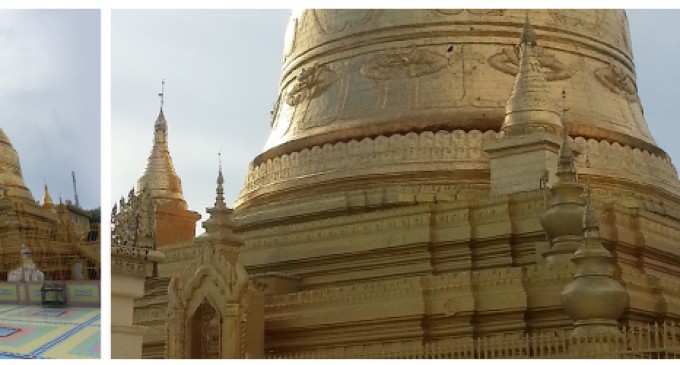Ponnya Shin pagoda

Just opposite to the three capitals of Myanmar kings Inwa, Amarapura and Mandalay and running along the west bank of the mighty River Ayeyarwaddy is a range of wooded hills commonly known as Sagaing hills, the abode of holy recluses. The average elevation of this pleasant range is 684 feet above sea level. Dotted with religious monuments of different sizes and shapes belonging to different periods of Myanmar history the entire hill range has been the habitant of those who have renounced the mundane life to search for truth and ultimate peace in seclusion.
Towering above countless temples, stupas, monasteries and nunneries, located on the highest summit is a pagoda of world renown “Ponnya Shin”. Myanmar Buddhists add a prefix “Swan Oo” to the name and call it “Swan Oo Ponnya Shin” because it is believed that you can never be the first in the morning to offer early food to this Pagoda as there always is “Swan” (Cooked rice) already offered to it before you. Just like a palace tower at the centre of an old Myanmar Palace city Ponnya Shin stands at the very centre of the Sagaing hills. From its vantage point you can see Inwa, Amarapura and Mandalay on the east bank of the River and the blue Shan mountains in distance to the east; Sagaing town and the Ayeyarwaddy just below. The panorama from the Pagoda’s precinct is spectacular and breathtaking whichever direction you turn to.
Naturally, the Pagoda of such renown at such a unique position is shrouded with mysteries, legends and histories. The hill which bears it has many stories to tell. It was called Thaylar Pabhada hill in the time of Kakkusanda Buddha, Wingsara hill in the time of Konagomana Buddha, Dhammika hill in the time of Kassapa Buddha and Nagadhatha hill in the time of Gotama Buddha. Besides, the people call it Nga Hpar hill (The Frog hill) because its shape resembles a frog. Today it is well-known as Ponnya Shin hill.
There are references to and accounts of Ponnya Shin Pagoda in many sources – stone inscriptions, chronicles, literature and songs of different Myanmar historic periods. One can compile a research work on them. Monk U Thawbita, pen named Shwe Kaing Thar, an ex-staff of Archaeology Department, Mandalay had compiled and published in 1960 a book in vernacular entitled “History of Swan Oo Ponnya Shin Pagoda”. To mention but a few of source material are the stone inscription of A.D. 1590 of King Thalun, the stone inscription of King Bodawpaya on the platform of the Pagoda. Taung Hpila Sayadaw’s reply letter to King Thalun dated 1640, U Kala’s Maha Yazawun Tawkyi (Chronicle), Hman Nan Yazawuntawkyi (Glass Palace Chronicle), Meikthila Monk’s history of Ponnya Shin Zedi Taw, Taunghpila Sayadaw’s History of Sagaing hills, verses of the Inwa King 1451, Poet Zaya Yandameik’s poems, Poet Shin Htwe Nathein’s Ratu A.D. 1605 and verses on Ponnya Shin Zedi by Sagaing Nyaungbin Tha U Ponnya.
Among many versions and different legends and stories, the common data found in them may be compiled as follows:
The Pagoda was already in existence in Pinya Period. The year of the building of Ponnya Shin was sometimes mentioned as “coinciding with the date of the founding of a new city state “Pinya” in A.D. 1312 by King Thihathu. At the inauguration ceremony of his palace at the new capital Vijayapura, many tributes and presents were received from his lords. Queen Pwa Saw of Bagan honoured him with the gift of a gold cup and stand and a gold girdle she received from King Anawrahta. A strange gift was sent to him from overseas. It was an octagonal gold pickled tea container in which were hidden seven sacred relics of the Buddha. The container had seven gold screws and the word “seven” inscribed on it. When the King ate the pickled tea from this container, he was immediately caught up with elf an irresistible itch on his body. He sent the gold container to his goldsmith Nga Sein Thin to break it open and see its content. Nga Sein Thin found seven sacred relics hidden inside. Not knowing what they really were, Nga Sein Thin hammered one relic which got entered the anvil and the second one he hammered entered into the hammer. He took the remaining five relics and the dismantled gold container to the King by the seven gold screws and the inscribed word “seven” in the gold container, there should be seven relies in it. The King held Nag Sein Thin responsible for the loss of two relics. When the order was issued to arrest Nga Sein Thin, he fled with his hammer and anvil.
He crossed the Ayeyarwaddy in the darkness of night and reached the house of his old friend Amatkyi U Ponnya in Sagaing. Amatkyi U Ponnya, was a junior minister who served under King Thihathu of Pinya and his son King Athin Khayar Saw Yun of Sagaing. Nga Sein Thin stayed in that house for sometime. One night the two relics came out from the hammer and anvil and flew up emitting rays of light. Amatkyi U Ponnya saw this phenomenon and he knew that Nga Sein Thin had brought two sacred relics of the Buddha. In the morning Amatkyi U Ponnya asked Nga Sein Thin about the two relics. Nga Sein Thin explained what had happened to him in Pinya and said he knew nothing about the two relics, but he promised to hand them over to AmatKyi U Ponnya if he had them with him. One night the two relics came out and ascended into the sky emitting colourful rays of light Amatkyi U Ponnya and Nga Sein Thin witnessed that strange happen-ing. On Amatkyi U Ponnya’s request the two relics came down to rest in the ruby-studded gold casket on the shrine.
Amatkyi U Ponnya decided to enshrine the two sacred relics in a pagoda. One day he sent an errand boy to take the two sacred relics encased in the ruby-stidded gold casket in a gold plate to the summit of a hill and leave them at an auspicious site where they should be enshrined. Meanwhile Amatkyi Ponnya appealed to the deities to guide the errand boy to find the auspicious site. The errand boy went up to the summit of the Frog hill and left the relics cashed on the ground between two old pagodas— one built by Emperor Asoka and the other built by Padu Sangha Yaza Sayadaw. In AD 1322 Amatkyi U Ponnya and Nga Sein Thin built a pagoda, enshrining the two old pagodas, and the two encased sacred relics left on the ground between the two old pagodas.
On hearing the news of this event, King Athin Khaya Saw Yun became angry for the pagoda was built without royal notice and permission. The two builders were sent to jail to be tried by water ordeal. Later the King’s wrath subsided and he set them free with the royal permission of King Thihathu of Pinya, Athin Kha Ya Saw Yun, Amatkyi U Ponnya and gold smith Nga Sein Thin completed the Pagoda with gilt and a hti on it. Since then the Pagoda had been commonly known as Ponnya Shin. Successive Myanmar Kings maintained and renovated it and dedicated paddy fields and field workers to it.
In a fully illustrated booklet entitled “Wel-come to Sagaing hills” published by the Sitagu missionary Association,a commemorative issue of the world Buddhist Summit held in Yangon 9-11 December 2004, the following paragraph epitomises the sublime glory of Swan Oo Pon-nya Shin Pagoda and the natural beauty of its surrounding.
“If you ascend the Eiffel Tower in Paris the view you gain hardly compares with what you see when you climb the long covered stairways leading to Swan Oo Ponnya Shin. These paths wind a long up and down as if following the spine of a giant serpent. Your climb will first take you past a succession of monasteries and nunneries, some of them quite picturesque, then pagodas, and then just down below the summit a cluster of Little shops selling refresh-ments and souvenirs. Leisurely ascending, descending and ascending again, you can catch sight of any particular spot along the way, from many different angles and elevations. Swan Oo Ponnya Shin is itself entirely covered with gold, so if one reaches the Pagoda plat-form at midday, the monument will shine too brilliant to behold. At other time especially in the early morning and late afternoon, it takes on every nuance of the sun. It is all very beautiful and visiting it, is really an enjoyable experience”.
Dr. Khin Maung Nyunt
./wp-content/uploads/2018/10/Emirate-Online-TDY.png)
















There are no comments at the moment, do you want to add one?
Write a comment